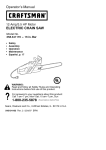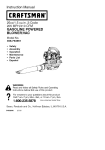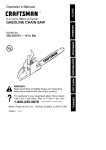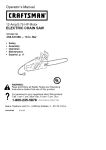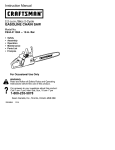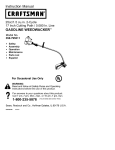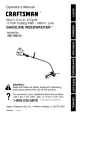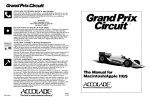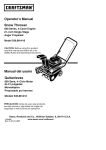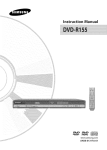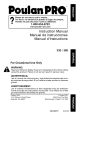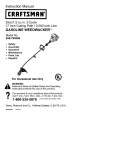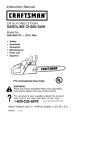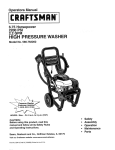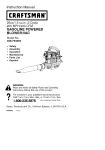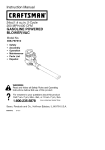Download CRAFTSMA - Sears Parts
Transcript
Operator's
g
g
e
Manual
CRAFTSMA
2,6 cu.in./42cc 2-Cycle
GASOLINE
CHAIN SAW
Model No.
358.350280
- 18 in. Bar
@
&
0
WARNING:
Read and follow all Safety Rules and Operating
Instructions
before first use of this product.
For
Call answers
7 am-7
to your
questions or about
this pm,
product:
pm,
Mon.-Sat.,
10 am-7
Sun.
1-800-235-5878
Sears, Roebuck
530087860
8/20/00
<Hoo,o ,,sted are Centra,
and Co., Hoffman
Estates,
Time)
IL 60179 USA
0
g
Warranty
Safety Rules
Assembly
Operation
Maintenance
Service and Adjustments
2
2
5
6
Storage
Trouble Shooting Chart
Emissions Statement
Parts List
Spanish
Parts & Ordering
tl
14
FULL ONE YEAR WARRANTY
ON CRAFTSMAN
16
17
18
20
23
Back
GAS CHAIN SAW
For one year from the date of purchase, when this Craftsman Gas Chain Saw is
maintained, lubricated and tuned up according to the operator's manual, Sears
wilt repair, free of charge, any defect in material or workmanship.
This warranty excludes the bar, chain, spark plug and air filter, which are
expendable parts and become worn during normal use.
If this Gas Chain Saw is used for commercial or rental purposes, this warranty
applies for 30 days from the date of purchase.
WARRANTY SERVICE IS AVAILABLE BY RETURNING THIS CHAIN SAW TO THE
NEAREST SEARS SERVICE CENTER IN THE UNITED STATES.
This warranty gives you specific
which vary from state to state.
Sears, Roebuck
legal rights, and you may also have other rights
and Co., D/817 WA, Hoffman
A_kWARNING:
Always disconnect
spark plug wire when making repairs
except for carburetor adjustments. Because a chain saw is a high-speed
woodcutting tool, careless or improper
use of this toot can cause serious
injury.
PLAN AHEAD
• Restrict the use of your saw to adult
users who understand and can follow
the safety rules, precautions, and operating instructions found in this
•
•
manual
Hearing
Protection
Snug
Fitting
_
A.,L/_
I q_'g I'_-_
_
•
Heavy Duty
Clothing
Safety
Shoes
Safety Hat
Eye
Protection
_oves
%
_m
•
• Wear protective gear. Always use
steel-toed safety footwear with nonslip soles; snug-fitting clothing;
2
Eotateo,
IL 60179
heavy-duty, non-slip gloves; eye protection such as non-fogging, vented
goggles or face screen; an approved
safety hard hat; and sound barriers
(ear plugs or mufflers) to protect your
hearing. Regular users should have
hearing checked regularly as chain
saw noise can damage hearing. Secure hair above shoulder length.
Keep all parts of your body away
from the chain when the engine is
running,
Keep children, bystanders, and animals at least 30 feet (10 meters)
away from the work area when starting and using the saw.
Do not handle or operate a chain
saw when you are fatigued, ill, or upset, or if you have taken alcohol,
drugs, or medication. You must be in
good physical condition and mentally
alert. If you have any condition that
might be aggravated by strenuous
work, check with doctor before operating.
Do not start cutting until you have a
clear work area, secure footing, and
especially if you are felling a tree, a
retreat path.
OPERATE
YOUR
SAWSAFELY
• Do not operate with one hand. Serious injury to the operator, helpers, or
bystanders may result from onehanded operation. A chain saw is intended for two-handed use.
• Operate the chain saw only in a weltventilated outdoor area.
• Do not operate saw from a ladder or
in a tree, unless you are specifically
trained to do so.
• Make sure the chain will not make
contact with any object while starting
the engine. Never try to start the saw
when the guide bar is in a cut.
• Do not put pressure on the saw, especially at the end of the cut. Doing
so can cause you to lose control
when the cut is completed,
• Stop engine before setting saw
down.
• Hand carry saw only when engine is
stopped. Carry with muffler away
from body; guide bar & chain projecting behind you; guide bar preferably
covered with a scabbard.
MAINTAIN
YOUR
SAW tN GOOD
WORKING ORDER
• Have all chain saw service performed by a quaIified service dealer
except the items listed in the maintenance section of this manual.
• Make certain the saw chain stops
moving when the throttle trigger is
released. For correction, refer to
CARBURETOR ADJUSTMENTS.
• Keep the handles dry, clean, and
free from oil or fuel mixture.
• Keep caps and fasteners securely
tightened.
• Use only Craftsman accessories and
replacement parts as recommended.
Never modify your saw.
HANDLE FUEL WITH CAUTION
• Do not smoke while handIing fuel or
while operating the saw.
• Eliminate all sources of sparks or
flame in areas where fuel is mixed or
poured.
• Mix and pour fueI in an outdoor area
and use an approved, marked container for all fuet purposes. Wipe up
atl fuel spilis before starting saw.
• Move at least 10 feet (3 meters) from
fueiing site before starting.
• Turn the engine off and tet saw coot
in a non-combustible
area, not on
dry leaves, straw, paper, etc, Slowly
remove fuet cap and refuet unit.
• Store the unit and fuel in a coot, dry
well ventilated space where fuel vapors cannot reach sparks or open
flames from water heaters, electric
motors or switches, furnaces, etc.
GUARD AGAINST KICKBACK
Follow all safety rules to help avoid
kickback and other forces which can
result in serious
injury.
Clear The Working Area
A0&WARNING:
Rotational
Kickback
can occur when the moving chain contacts an object at the upper portion of
the tip of the guide bar, Contact at the
upper portion of the tip of the guide bar
can cause the chain to dig into the object, which stops the chain for an
instant. The result is a lightning fast,
reverse reaction which kicks the guide
bar up and back toward the operator.
Pinch-Kickback
and Pull-In occur
when the chain is suddenly stopped by
being pinched, caught, or by contacting a foreign object in the wood. This
sudden stopping of the chain results in
a reversat of the chain force used to
cut wood and causes the saw to move
in the opposite direction of the chain
rotation. Pinch-Kickback
drives the
saw straight back toward the operator.
Putt-In pulls the saw away from the operator.
REDUCE THE CHANCE OF
KICKBACK
• Recognize that kickback can happen.
With a basic understanding of kickback, you can reduce the element of
surprise which contributes to accidents.
• Never tet the moving chain contact
• any object at the tip of the guide bar.
Keep working area free from obstructions such as other trees, branches,
rocks,
fences,
stumps,
etc.Eliminate left thumb under the front handlebar.
oravoid
anyobstruction
thatyour
Keep your left arm straight with the
elbow locked.
sawchain
couldhitwhile
cutting.
• Keep
sawchain
sharp
andproperly • Position your left hand on the front
tensioned.
Aloose
ordullchain
can
handlebar so it is in a straight line
increase
thechance
ofkickback.
with your right hand on the rear hanFollow
manufacturer's
chain
sharp- dle when making bucking cuts.
ening
andmaintenance
instructions. Stand slightly to the left side of the
Check
tension
atregular
intervals, saw to keep your body from being in
butnever
withengine
running.
Make a direct line with the cutting chain.
surebarclamp
nutsaresecurely • Stand
with your weight evenly balanced on both feet.
tightened.
• Do not overreach. You could be
• Begin
andcontinue
cutting
atfuit
drawn or thrown off balance and lose
speed.
Ifthechain
ismoving
ata
control.
slower
speed,
thereisgreater
chance
ofkickback
occurring.
• Do not cut above shoulder height. It
• Useextreme
caution
when
reenter- is difficult to maintain control of saw
ingacut.
above shoulder height.
• Donotattempt
cutsstarting
withthe KICKBACK SAFETY FEATURES
tipofthebar(ptunge
cuts),
• Watch
forshifting
logsorother
forces '_I'WARNING:
The following feathatcould
close
acutandpinch
or
tures are included on your saw to help
fallintochain.
reduce hazard of kickback; however,
• Usethespecified
Reduced-Kickback
features will not totally eliminate
Guide
BarandLow-Kickback
Chain. such
this danger. Do not rely only on safety
Avoid Pinch-Kickback:
• Be extremely aware of situations or
obstructions that can cause material
to pinch the top of or otherwise stop
the chain.
• Do not cut more than one tog at a
time.
• Do not twist saw as bar is withdrawn
from an undercut when bucking.
Avoid Pull-In:
• Always begin cutting with the engine
at full speed and the saw housing
against wood.
• Use wedges made of plastic or
wood, Never use metal to hold the
cut open.
MAINTAIN CONTROL
Stand to the left of the saw
Thumb on
underside
\[
of handlebar
devices.
• Handguard: designed to reduce the
chance of your left hand contacting
the chain if your hand slips off the
front handlebar.
• Position of front and rear handlebars:
designed with distance between
handles and "in-line" with each other.
The spread and "in-line" position of
the hands provided by this design
work together to give balance and
resistance in controlling the pivot of
the saw back toward the operator if
kickback occurs.
• Reduced-Kickback
Guide Bar: designed with a small radius tip which
reduces the size of the kickback
danger zone. This type bar has been
demonstrated to significantly reduce
the number and seriousness of kickbacks when tested in accordance
with ANSI B175.1.
r_.
Small Radius
Tip Guide Bar
Never reverse h'_nd'positions
locked
• A good, firm grip on the saw with
both hands will help you maintain
control. Don't let go. Grip the rear
handle with your right hand whether
you are right or left handed. Wrap the
fingers of your left hand over and
around the front handlebar, and your
Large Radius
Tip Guide Bar [
/
• Low-Kickback Chain: has met kickback performance requirements when
tested on a representative sample of
chain saws below 3.8 cubic inch
displacement specified in ANSI Bt75.1.
Low-Kickback
Chain
Contoured
Depth
Gauge
Deflects
Kickback
Force
And
Allows
_ Wood
Iongated
To
Gradually
Guard
Link
Ride
kltoCutter
SAFETY NOTICE: Exposure to
vibrations through prolonged use of
gasoline powered hand tools could
cause blood vessel or nerve damage
in the fingers, hands, and joints of
people prone to circulation disorders or
abnormal swelling. Prolonged use in
cotd weather has been linked to blood
vessel damage in otherwise healthy
people, tf symptoms occur such as
numbness, pain, toss of strength,
change in skin color or texture, or loss
of feeling in the fingers, hands, or
joints, discontinue the use of this tool
and seek medical attention. An
anti-vibration system does not
guarantee the avoidance of these
problems. Users who operate power
tools on a continual and regular basis
must closely monitor their physical
condition and the condition of this toot.
CHAIN BRAKE: tf this saw is to be
used for commercial logging, you must
order and install a chain brake to com-
CARTON CONTENTS
Check carton contents against the following list.
Model 358.350280
Chain Saw (fully assembled)
Bar toot
2-cycle engine oil
Chain sharpening tool
Carrying case
Gloves
Wedge
Log carrier
Pruning saw
ply with Federal QSHA Regulations for
Commercial Logging. Contact your
Sears Service Center or catt
1-800-235-5878.
SPARK ARRESTOR:
Your saw is
equipped with a temperature limiting
muffler and spark arresting screen
which meets the requirements of
California Codes 4442 and 4443. Ati
U.S. forest land and the states of
California, Idaho, Maine, Minnesota,
New Jersey, Oregon, and Washington
require by law that many internal
combustion engines be equipped with
a spark arrestor screen. If you operate
a chain saw in a state or locale where
such regulations exist, you are legally
responsible for maintaining the
operating condition of these parts.
Failure to do so is a violation of the
law. Refer to Customer
Responsibilities
chart in the
MAINTENANCE section.
STANDARDS:
This chain saw is listed
by Underwriters Laboratories, Inc. in
accordance with American National
Standards for Gasoline-Powered
Chain Saws Safety
(ANSI Bt 75.t-t 99t).
Requirements
Examine parts for damage. Do not use
damaged parts.
If you need assistance or find that
parts are missing or damaged, please
call 1-800-235-5878.
NOTE: It is normal to hear the fuel filter
rattle in an empty fuel tank.
Your unit has been factory tested and
the carburetor precisely adjusted. As a
result you may smell gasoline or find a
drop of oil/fuet residue on the muffler
when you unpack the unit.
ASSEMBLY
Your saw is fully assembled;
assembly is necessary.
no
KNOW
YOUR
SAW
READ THIS OPERATOR'S MANUALAND SAFETY RULES BEFORE OPERATING YOUR
CHAIN SAW. Compare the illustrations with your unit to famiIiarize yourself with the
location of the various controls and adjustments. Save this manual for future reference,
Bar Tool
(chain adjustment)
Front Handle
J
Starter Rope
_j
ON/STOP
Muffler
Chain
witChpdmer
CRAFTSMRN
Bulb
Bar Oil Fill Cap
Starter
Housing
Fuel Mix Fill Cap
Cylinder Cover
Chain
Direction
of Travet
Throffle
Lockout
Rear
Handle
Throttle
Trigger
Choke Bar Clamp Chain Bar Clamp Nuts
Lever
Catcher
ON/STOP SWITCH
The ON/STOP SWITCH is used to stop
the engine,
THROTTLE TRIGGER
The THROTq-LE TRIGGER controls
Guide Bar
CHOKE/FAST
IDLE LEVER
The choke and fast idte are set by pulling the CHOKE/FAST IDLE LEVER out
fully for cotd or refueled starting, The
choke provides additional fuel to the
engine during cotd starting,
PRIMER BULB
The PRIMER BULB circulates fuel to the
carburetor to provide quicker starting.
en-
gine speed,
CHAIN TENSION
tt is normal for a new chain to stretch
during first 30 minutes of operation.
You should check your chain tension
frequentIy. See CHAIN TENSION under
the SERVICE AND ADJUSTMENTS section.
THROTTLE
LOCKOUT
The THROTTLE LOCKOUT must be
pressed before you can squeeze the
throttle trigger, This feature prevents
you from accidentaIly squeezing the
trigger.
6
BEFORE
STARTING
ENGINE
4_WARNING:
Be sure to read the
fuel handling information in the safety
rules section of this manual before you
begin, tf you do not understand the
fuel handling information do not attempt to fuel your unit. Seek help from
someone that does understand the information or cati the customer assistance help line at 1-800-235-5878.
GUIDE BAR AND CHAIN OIL
The chain oiler provides continuous
lubrication to the chain and guide bar.
Be sure to fitI the bar oil tank when you
flit the fuet tank (Capacity = 6.8 ft. oz.).
For maximum guide bar and chain life,
we recommend you use Craftsman
chain saw bar oil. If Craftsman bar oit
is not available, you may use a good
grade SAE 30 oil untit you are aMe to
obtain Craftsman brand. The oil output
is automatically metered during operation. Your saw will use approximately
one tank of bar oil for every tank of fuel
mix. Always fill the bar oit tank when
you fill the fueI tank.
FUELING ENGINE
This engine is certified to operate on
unIeaded gasoIine. Before operation,
gasotine must be mixed with a good
quality 2-cycte air-cooled engine oil.
We recommend Craftsman brand oil
Mix gasoline and oil at a ratio of 40:1
(A 40:1 ratio is obtained by mixing 3.2
ounces of oil with 1 gailon of unleaded
gasoline). DO NOT USE automotive oil
or boat oil These oils will cause
engine damage. When mixing fuel
follow the instructions printed on the
container.
Once oiI is added to the gasoline,
shake container momentarily to assure
that the fuel is thoroughly mixed.
Always read and foltow the safety ruIes
relating to fuel before fueling your unit.
IMPORTANT
Experience indicates that alcohoI
blended fuels (catied gasohoI or using
ethanol or methanoI) can attract moisture which leads to separation and
formation of acids during storage. Acidic
gas can damage the fuel system of an
engine white in storage.
To avoid engine problems, the fuel system should be emptied before storage
for 30 days or longer. Drain the gas
tank, start the engine and _etit run until
the fuel tines and carburetor are empty.
Use fresh fuel next season. See STORAGE instructions for additional information.
Never use engine or carburetor cleaner products in the fuel tank or permanent damage may occur.
See the STORAGE section for additional information.
mLWARNING:
The chain must not
move when the engine runs at idle
speed, if the chain moves at idle
speed, refer to CARBURETOR ADJUSTMENTwithin this manual. Avoid contact with the muffler. A hot muffIer can
cause serious burns.
STOPPING
YOUR
ENGINE
• Move ON/STOP switch to STOP.
STARTING YOUR ENGINE
To start the engine, hoid the saw firmly
on the ground as illustrated. Make
sure the chain is free to turn without
contacting any object.
Important point8 to remember
When pulting the starter rope, do not
use the fut[ extent of the rope as this
can cause the rope to break. Do not
let starter rope snap back. Hold the
handle and [et the rope rewind slowly.
For cold weather starting, start the unit
at FULL CHOKE; allow the engine to
warm up before squeezing the throttle
trigger. Do not cut material with the
choke/fast idle lever at the FULL
CHOKE position.
Starter Rope Handle
/
('k_l_-_.k _
_
Lett Hand
_
on Front
Right Foot Through Rear Handle
COLD ENGINE OR WARM ENGINE
AFTER RUNNING OUT OF FUEL
NOTE: tn the following steps, when
the choke/fast idte lever is pulled out to
the fuit extent, the correct throttIe setting for starting is set automatically.
Primer _
Bulb
Switch
On/Stop
• Move
ON/STOP
switch
toONposition.•
Ch°keC°b
• Pulloutchoke/fast
idletothefullextent.
• Slowly
press
primer
bulb6times.
• Pullthestarter
rope
quickly
withyour
righthand
5times;
thenpush
the
choke/fast
idlelever
incompletely
(to
theOFF
CHOKE
position).
• Pullthestarter
rope
quickly
withyour
righthand
untiltheengine
starts.
• Allow
theengine
torunforapproximately
fiveseconds.
Then,
squeeze
andrelease
throttle
trigger
toallow
engine
toreturn
toidlespeed.
STARTING
A WARM ENGINE
• Pull the choke/fast idle lever out to
the full extent, then push the lever
back in completely (to the OFF
CHOKE position).
• Slowly press primer bulb 6 times.
• Pull the starter rope quickly with your
right hand until the engine starts.
• Squeeze and release throttle trigger,
allowing engine to idle.
DIFFICULT STARTING OR
STARTING A FLOODED ENGINE
The engine may be flooded if it has not
started after 10 pulls.
Flooded engines can be cleared of excess fuel by following the warm engine
starting procedure listed above, tnsure
the ignition switch is in the ON position.
Starting could require pulling the starter rope handle many pulls depending
on how badly the unit is flooded. If engine still fails to start, refer to the
TROUBLESHOOTING CHART or call
1-800-235-5878.
OPERATING TIPS
• Check chain tension before first use
and after 1 minute of operation. See
CHAIN TENSION in the MAINTENANCE
section.
• Cut wood only. Do not cut metal,
plastics, masonry, non-wood building
materials, etc.
• Stop the saw if the chain strikes a
foreign object. Inspect the saw and
repair parts as necessary.
• Keep the chain out of dirt and sand.
Even a small amount of dirt will
quickly dull a chain and increase the
possibility of kickback.
Practice cutting a few small logs using the following steps. This will help
you get the '_feel" of using your saw
before you begin a major sawing operation.
• Squeeze the throttle trigger and allow the engine to reach fuIt speed
before cutting.
• Begin cutting with the saw frame
against the tog.
• Keep the engine at full speed the
entire time you are cutting.
• Allow the chain to cut for you. Exert
only light downward pressure.
• Release the throttle trigger as soon
as the cut is completed, allowing
the engine to idle. If you run the
saw at futt throttle without a cutting
load, unnecessary wear can occur.
• To avoid losing control when cut is
complete, do not put pressure on
saw at end of cut.
• Stop engine before setting saw
down.
TREE
FELLING
4HII,WARNING:
dead branches
TECHNIQUES
Check for broken or
which can fall while
cutting causing serious injury. Do not
cut near buildings or electrical wires if
you do not know the direction of tree
fall, nor cut at night since you wilt not
be able to see welt, nor during bad
weather such as rain, snow, or strong
winds, etc.
• Carefully plan your sawing operation
in advance.
• Clear the work area. You need a
clear area all around the tree so you
can have secure footing.
• Study the natural conditions that can
cause the tree to fall in a particular
direction. These conditions include:
• The wind direction and speed.
• The lean of the tree. The lean of a
tree might not be apparent due to
uneven or sloping terrain. Use a
plumb or level to determine the direction of tree lean,
• Weight and branches on one side.
• Surrounding trees and obstacles.
• Look for decay and rot. If the trunk is
rotted, it can snap and fall toward the
operator.
• Make sure there is enough room for
the tree to fall. Maintain a distance of
2-1/2 tree lengths from the nearest
person or other objects. Engine
noise can drown out a warning call.
• Remove
dirt,stones,
loose
bark,
nails,
staples,
andwirefromthetree
where
cutsaretobemade.
_'9_bPlanaclear
retreat
path
t _ -_- Direction
of Fall
45
._
FELLING LARGE TREES
(6 inches in diameter or larger)
The notch method is used to felI large
trees. A notch is cut on the side of the
tree in the desired direction of fall. After
a felling cut is made on the opposite
side of tree, the tree will tend to felt in
the direction of the notch.
NOTE: if tree has targe buttress roots,
remove them before making the notch.
NOTCH CUT AND FELLING TREE
• Make notch cut by cutting the top of
the notch first. Cut through t/3 of the
diameter of the tree. Next complete
the notch by cutting the bottom. See
illustration. Once the notch is cut, remove the wedge of wood from tree.
FinaI cut here
First cut _"_1
Notch
\
Hinge
• After removing the wood, make the
felling cut on the opposite side of the
notch. This is done by making a cut
about two inches higher than the
center of the notch. This will leave
enough uncut wood between the felling cut and the notch to form a hinge.
This hinge wi_I hetp prevent the tree
from falling in the wrong direction.
Hinge holds tree on
stump and helps
control fail
NOTE: Before felling cut is complete,
use wedges to open the cut when
necessary to control the direction of
fall, To avoid kickback and chain
damage, use wood or plastic wedges,
but never steeI or iron wedges.
• Be alert to signs that the tree is
ready to fall: cracking sounds, widening of the felling cut, or movement in
the upper branches.
• As tree starts to fa}l, stop saw, put ft
down, and get away quickly on your
planned retreat path.
• Be extremely cautious with partially
fallen t_ees that may be poorly supported. When e tree doesn't fall completely, set the saw aside and putt
down the tree with a cable winch,
bIock and tackle, or tractor Do not
use your saw to cut down a partially
fatten tree.
CUTTING A FALLEN TREE
(BUCKING)
Bucking is the term used for cutting a
fallen tree to the desired tog size.
,_t, WARNING:
Do not stand on the
log being cut. Any portion can roll
causing toss of footing and control. Do
not stand downhill of the log being cut.
IMPORTANT POINTS
• Cut onty one log at a time.
• Cut shattered wood very carefully;
sharp pieces of wood could be flung
toward operator.
• Use a sawhorse to cut small logs.
Never allow another person to hold
the log while cutting and never hold
the log with your leg or foot.
• Do not cut in an area where logs,
limbs, and roots are tangled. Drag logs
into a clear area before cutting them.
BUCKING
TECHNIQUES
_t, WARNING:
If saw becomes
pinched or hung in a log, don't try to
force it out. You can lose control of the
saw _est_lting in in}ury a_d/or damage
to the saw. Stop the saw, drive a
wedge of plastic or wood into the cut
until the saw can be removed easily. Restart saw and cs.refutly reenter the cut.
Do not use a metal wedge. Do not attempt to restart your saw when it is
pinched or hung in a log.
1st Cut
Turn saw OPF and use a plastic or
wooden wedge to force cut open
Overcutting
begins on the top side of
the log with the bottom of the saw
against the log. When overcutting use
light downward pressure.
Overcutting
Undercutting
BUCKING USING A LOG OR
SUPPORT STAND
• Remember your first cut is atways on
the compression side of the log. (Refer to the illustration below for your
first and second cut).
• Your first cut should extend t/3 of the
diameter of the log.
• Finish with your second cut.
Undercutting involves cutting on the
underside of the log with top of saw
against the tog. When undercutting
use Iight upward pressure, Hold saw
firmly and maintain control The saw
wilt tend to push back toward you.
_WARNING:
Never turn saw upside down to undercut. The saw cannot be controlled in this position,
2rid Cut __
Always make your first cut on the
compression side of the log.
First cut on compression side of log
Second
LIMBING
cut
First cut on compression side of log
BUCKING WITHOUT A SUPPORT
• Overcut through 1/3 of the diameter
of the log,
• Roll the tog over and finish with a
second overcut.
• Watch for togs with a compression
side. See illustration above for cutting togs with a compression side.
Using a log
for support
2nd Cut ,_
_1
AND PRUNING
d_WARNING:
Never climb into a
tree to limb or prune. Do not stand on
ladders, platforms, a log, or in any position which can cause you to lose
your balance or controt of the saw.
IMPORTANT POINTS
• Watch out for springpoles.
Springpotes are small size limbs
which can whip toward you, or pult
you off balance. Use extreme caution when cutting small size limbs.
• Be alert for springback. Watch out for
branches that are bent or under
pressure. Avoid being struck by the
branch or the saw when the tension
in the wood fibers is released.
• Frequently clear branches out of the
way to avoid tripping over them.
LIMBING
• Limb a tree only after it is cut down.
• Leave the larger limbs underneath the
felled tree to support the tree as you
work.
• Start at the base of the feIled tree and
work toward the top, cutting branches
and limbs. Remove small limbs with
one cut.
stCut
10
• Keep the tree between you and the
chain.
• Remove larger, supporting branches
with the 1/3, 2/'3 cutting techniques described in the bucking section.
• Always use an overcut to cut small
and freely hanging limbs. Undercutting
could cause limbs to fall and pinch the
through the bottom of the limb.
• Next make a second cut all the way
through the limb.
• Finish the pruning operation by using
an overcut so that the stump of the
timb protrudes 1 to 2 inches from the
trunk of the tree.
Second cut
SaW.
/
PRUNING
_iLWARNING:
1/3 of way
Limit pruning to limbs
shoulder height or below. Do not cut if
branches are higher than your shoulder. Get a professional to do the job.
• Make your first cut t/3 of the way
CUSTOMER
_/'f_
3rd cut
from
trunk
t toof2in
tree
RESPONSIBILITIES
Fitt in dates as you complete
regular service
Check for damaged/worn
Before
Use
After
Use
Every
5 hrs,
Every
25 hrs.
Yearly
Service
Dates
parts
Check for loose fasteners/parts
Check chain tension
Check chain sharpness
v"
Check guide bar
Clean unit & labels
Clean air filter
Clean/inspect
spark arrestor
screen & inspect muffler
Replace spark plug
Replace air filter
GENERAL
RECOMMENDATIONS
The warranty on this unit does not cover items that have been subjected to
operator abuse or negligence. To receive fult value from the warranty, the
operator must maintain unit as instructed in this manual. Various adjustments
witt need to be made periodically to
properly maintain your unit.
• Once a year, replace the spark plug,
air filter element, and check guide
bar and chain for wear. A new spark
plug and air filter element assures
proper air-fuel mixture and helps
your engine run better and last longer.
,11_WARNING:
Disconnect
the spark
plug before performing maintenance
except for carburetor adjustments.
LUBRICATION
Bar
Sprocket
Bar OiI
Fill Cap
CHECK FOR DAMAGED OR
WORN PARTS
Replacement of damaged/worn
parts
should be referred to your Sears Service Center.
NOTE: tt is normal for a smatl amount
of oil to appear under the saw after engine stops. Do not confuse this with a
leaking oil tank.
• ON/STOP Switch - Ensure ON/STOP
switch functions properly by moving
the switch to the STOP position.
11
Make sure engine stops; then restart
engine and continue.
• Fue_ Tank - Do not use saw if fuet
tank shows signs of damage or
leaks.
• Oil Tank - Do not use saw if oil tank
shows signs of damage or leaks.
CHECK FOR LOOSE
FASTENERS AND PARTS
Bar Clamp Nut
Chain
Muffler
Cylinder Shield
Air Filter
Clutch Drum/Sprocket
Handle Screws
Vibration Mounts
Starter Housing
Handguard
CHECK CHAIN TENSION
• Use the screwdriver end of the bar
toot to move chain around guide bar
to ensure kinks do not exist. The
chain should rotate freely.
Bar Ctamp Nuts
• Loosen bar clamp nuts untit they are
finger tight against the bar clamp.
• Turn adjusting screw until chain
barely touches the bottom of guide
bar.
• Use the screwdriver
end of the bar
toot to move chain around guide bar.
• If chain does not rotate, it is too tight.
Slightly loosen bar clamp nuts and
loosen chain by turning the adjusting
screw. Retighten bar clamp nuts.
• If chain is too loose, it wilt sag below
the guide bar. DO NOT operate the
saw if the chain is loose.
CHECK CHAIN SHARPNESS
A sharp chain makes wood chips. A
dull chain makes a sawdust powder
and cuts slowly.
CHAIN SHARPENING
Chain sharpening requires speciat
tools. You can purchase sharpening
tools at Sears or go to a professional
chain sharpener.
CHECK GUIDE BAR
Conditions which require guide bar
maintenance:
• Saw cuts to one side or at an angle.
• Saw has to be forced through the
cut.
• Inadequate supply of oil to bar/chain.
Check the condition of guide bar each
time chain is sharpened. A worn guide
bar will damage the chain and make
cutting difficult, To maintain guide bar:
• Move ON/STOP switch to STOP
• Remove bar and chain from saw.
• Clean all sawdust and any other
debris from the guide bar groove and
sprocket hole after each use.
From Guide
Bar
Remove
Sawdust__
Groove
• Using bar toot, roll chain around guide
bar to ensure all links are in bar
groove.
• Lift up tip of guide bar to check for
sag. Release tip of guide bar, then
turn adjusting screw until sag does
not exist.
• While lifting tip of guide bar, tighten
bar clamp nuts with the bar tool.
Torque to 10-15 ft-lbs.
0
le
• Add lubricant to sprocket hole after
each use.
• Burring of guide bar rails is a normat
process of raii wear. Remove these
burrs with a flat file.
• When rail top is uneven, use a flat
file to restore square edges and
sides.
]_r
Worn Groove
12
Fi_eEdges
sides Square
and
[_]
Correct Groove
Muffler Diffuser
Replace guide bar when the groove is
worn, the guide bar is bent or cracked,
or when excess heating or burring of the
rails occurs, tf replacement is necessary,
use only the guide bar specified for your
saw in the repair parts list or on the decal located on the chain saw.
CLEAN UNIT & LABELS
• Clean the unit using a damp cloth
with a mild detergent.
• Wipe off unit with a clean dry cloth.
CLEAN AIR FILTER
A dirty air filter decreases the life and
performance of the engine and increases fuel consumption and harmfut
emissions. Always clean your air filter
after 15 tanks of fueI or 5 hours of operation, whichever comes first. Ciean
more frequently in dusty conditions. A
used air filter can never be completely
cleaned. It is advisable to replace your
air filter with a new one after every 50
hours of operation, or annually, whichever comes first. To clean filter:
• Loosen 3 screws on cylinder cover.
• Remove cylinder cover.
• Remove air filter.
• Clean the air filter using hot soapy
water. Rinse with ctean coot water.
Air dry completely before reinstalling.
• Lightly oil air filter before installing to
improve the efficiency of air filter.
Use 2-cycle engine oil or motor oil
(SAE 30), Squeeze excess oil from
filter.
• Reinstall air filter.
• Reinstall cylinder cover and 3 screws
(15-20 in-tbs.),
Air FiIter
S,,,,__
_
Cylinder Cover
rews
over
INSPECT MUFFLER AND SPARK ARRESTOR SCREEN
As the unit is used, carbon deposits
build up on the muffler and spark
arrestor screen, and must be removed
to avoid creating a fire hazard or affecting engine performance.
Replace the spark arrestor screen if
breaks occur.
/
Screen
CLEANING THE SPARK
ARRESTOR SCREEN
Cleaning is required every 25 hours of
operation or annually, whichever
comes first.
• Loosen and remove the 2 muffler
cover screws.
• Remove the muffIer cover (cover
snaps off muffler body).
• Remove muffler diffuser and spark
arrestor screen assembly, Notice the
orientation of these parts for reassembling.
• Clean the spark arrestor screen with
a wire brush. Repiace screen if
breaks are found.
• Replace any broken or cracked muftier parts.
• Reinstall diffuser and spark arrestor
screen assembty with round holes
facing up.
• Reinstall muffler cover and 2 screws
(7-8 ff-tbs).
REPLACE SPARK PLUG
The spark plug should be replaced
each year to ensure the engine starts
easier and runs better, tgnition timing
is fixed and nonadjustable.
• Loosen 3 screws on cylinder cover.
• Remove the cylinder cover.
• Pull offthe spark ptug boot.
• Remove spark plug from cylinder
and discard.
• Replace with Champion CJ7Y spark
plug and tighten with a 3/4 inch socket wrench (10-12 ff-lbs). Spark p_ug
gap should be .025 in.
• Reinstall the spark plug boot.
• Reinstall the cylinder cover and 3
screws (15-20 in-tbs).
Screws
Spark
13
Cylinder
_
Cover
CHAIN REPLACEMENT
WARNING:
Wear protective
gtoves when handling chain. The
chain is sharp and can cut you even
when it is not moving.
It is normal for a new chain to stretch
during the first 15 minutes of operation.
You shoutd recheck your chain tension
frequently and adjust the chain tension
as required. See CHAIN TENSION section.
• Move ON/STOP switch to the STOP
position.
• Replace the old chain when it becomes worn or damaged.
• Use only the Low-Kickback
replacement chain specified in the repair
parts list. The correct replacement
bar and chain is also specified on a
decal located on the chain saw.
• See your Sears Service Center to
replace and sharpen individual cutters on your chain.
• Remove bar clamp nuts.
• Remove bar clamp.
• Remove the oId chain.
/ ¸
Cutters
Drive Links
• Place chain over and behind clutch.
• Fit the bottom of the drive links between the teeth in the sprocket nose.
• Fit chain drive links into bar groove.
• Pull guide bar forward until the chain
is snug in the guide bar groove.
• Install the bar ctamp,
• Install bar clamp nuts; finger tighten
only. Do not tighten any further at this
point.
CHAIN ADJUSTMENT
See CHAIN TENSION in MAINTENANCE
section.
REPLACE
FUEL FILTER
To replace fuel filter, drain your unit by
running dry of fuei, remove fuel cap/retainer assembly from tank. Pull filter
from tank and remove from line, Replace and reassemble.
CARBURETOR
ADJUSTMENT
,_t, WARNING:
• Turn adjusting screw on bar to move
the tensioning rack as far as it will go
toward the front of the bar.
TensioningR_ack_
• Slide the guide bar rearward until it
stops against the sprocket,
• Carefully remove new chain from
package, Hold chain with the drive
finks as shown.
Depth Gauge
The chain will be
moving during most of this procedure.
Wear your protective equipment and
observe all safety precautions. During
the low speed mixture adjustment recheck idle speed after each turn of the
screw. The chain must not move at idle
speed.
Carburetor adjustment is critical and if
done improperly can permanently
damage the engine as weIt as the carburetor. If you require further assistance or are unsure about performing
this procedure, calt our customer assistance help line at 1-800-235-5878.
Old fuel, a dirty air filter, dirty fuel filter,
or flooding may give the impression of
14
an improperly adjusted carburetor.
Check these conditions before adjusting the carburetor.
The carburetor has been carefully set
at the factory. Adjustments may be
necessary if you notice any of the following conditions:
• Chain moves at idle. See IDLE
SPEED-T under adjusting procedure.
• Saw wJtt not idle. See iDLE SPEED-T
and LOW SPEED MIXTURE-L under
adjusting procedure.
• Engine dies or hesitates when it
should accelerate. See ACCELERATION CHECK under adjusting
procedure.
• Loss of cutting power. See HIGH
SPEED MIXTURE-H under adjusting
procedure.
There are three adjustment screws on
the carburetor. They are tabeted H, L,
and T. They are located in the area just
above the primer bulb.
CARBURETOR
PRESETS
When making adjustments, do not
force the plastic timiter caps beyond
the stops or damage will occur.
If carburetor presets are not needed,
proceed to iDLE SPEED-T.
• Turn both mixture screws counterclockwise until they stop,
• Turn the idle speed screw clockwise
until it stops. Now turn counterclockwise 4-1/2 full turns.
Start motor, let it run for 3 minutes, and
proceed to the adjustment section, if
engine does not start, refer to TROUBLESHOOTING CHART or cat_
1-800-235-5878.
If engine performance is acceptable at
the preset positions and there is no
chain movement at idle, no further adjustment is necessary.
ADJUSTING
PROCEDURE
Idle Speed-T
Allow engine to idle. Adjust speed until
engine runs without chain movement
or stalling.
• Turn clockwise to increase engine
speed if engine stalls or dies.
• Turn counterclockwise
to decrease
speed.
No further adjustments are necessary
if chain does not move at idle speed
and if performance
is satisfactory.
Low Speed Mixture-L
Allow engine to idle. Then accelerate
the engine and note performance. If
engine hesitates, bogs down, or
smokes during acceleration, turn mixture screw clockwise in 1/16-turn increments until performance is satisfactory.
Repeat this procedure as necessary
for proper adjustment. After completing
adjustments, check for acceleration
and chain movement at idle. Reset if
necessary.
High Speed Mixture-H
DO NOT operate engine at full throttle
for prolonged periods while making adjustments, Damage to the engine can
occur. Make a test cut. Based on performance of the saw while cutting, adjust the high speed mixture setting in
1/16-turn increments as follows:
• Clockwise until saw has good power
in the cut with no hesitation. Do not
adjust by sound or speed, but judge
by how well the saw performs in the
cut.
• Counterclockwise
if the saw has
speed, but dies in the cut or lacks
power in the cut.
After completing adjustments, check
for acceleration and chain movement
at idle. Reset if necessary.
Acceleration Check
If the engine dies or hesitates instead of
accelerating, turn the low speed mixture
adjustment counterclockwise until you
have smooth acceleration with no chain
movement at idle. Recheck and adjust
as necessary for acceptable performance.
15
Prepare your unit for storage at the
end of the season or if it wilt not be
used for 30 days or more.
,i_ WARNING:
• Allow the engine to cool, and secure
the unit before storing or transporting.
• Store chain saw and fuel in a well
ventilated area where fuel vapors
cannot reach sparks or open flames
from water heaters, electric motors or
switches, furnaces, etc.
• Store chain saw with all guards in
place and position chain saw so that
any sharp object cannot accidentally
cause injury.
• Store chain saw well out of the reach
of children.
EXTERNAL SURFACES
If your chain saw is to be stored for a
period of time, clean it thoroughly before storage. Store in a clean dry area.
• Lightly oil external metaI surfaces
and guide bar,
• Oil the chain and wrap it in heavy paper or cloth.
FUEL SYSTEM
Under FUELING ENGINE in the OPERATION section of this manual, see message tabeIed IMPORTANT
regarding
the use of gasohot in your chain saw.
Fuel stabilizer is an acceptable a_ter-
native in minimizing the formation of
fuel gum deposits during storage. Add
stabilizer to the gasoline in the fueI
tank or fuel storage container, Foltow
the mix instructions found on stabilizer
containers. Run engine at least 5 minutes after adding stabilizer.
Craftsman 40:1,2-cycle
engine oil (air
cooled) is especially blended with fuel
stabilizer. If you do not use this Sears
oil, you can add a fuel stabilizer to your
fuel tank.
ENGINE
• Remove spark plug and pour 1 teaspoon of 40:1,2-cycle
engine oil (air
cooled) through the spark plug opening. Slowly pull the starter rope 8 to
10 times to distribute oil.
• Replace spark plug with new one of
recommended type and heat range.
• Clean air filter.
• Check entire unit for loose screws,
nuts, and bolts. Replace any damaged, broken, or worn parts,
• At the beginning of the next season,
use onty fresh fuel having the proper
gasoline to oil ratio.
OTHER
• Do not store gasoline from one season to another.
• Replace your gasoline can if it starts
to rust.
16
TROUBLE
SHOOTING
CHART
TROUBLE
CAUSE
REMEDY
Engine will not
start or will run
only a few
seconds after
starting.
•
•
•
•
•
•
•
•
•
•
Ignition switch off.
Engine flooded.
FueI tank empty.
Spark plug not firing.
FueI not reaching
carburetor.
Move Ignition switch to ON.
See "Starting Instructions."
Fill tank with correct fuel mixture.
Install new spark plug.
Check for dirty fuet filter; replace.
Check for kinked or split fuel line;
repair or replace.
• See "Carburetor Adjustments."
• Carburetor requires
adjustment.
• None of the above.
Engine will not
idte property.
Engine will not
accelerate,
lacks power,
or dies under
a load.
Engine smokes
excessively.
• Contact Sears Service.
• Idle speed set too high
or too tow.
• Low Speed Mixture
requires adjustment.
• Crankshaft seals worn.
• Compression
tow.
• None of the above.
• See "Carburetor
Adjustments."
• See "Carburetor
Adjustments."
• Air filter dirty,
• Spark plug fouled.
• Clean or replace air filter.
• Clean or replace plug
and regap.
• See "Carburetor Adjustments."
• Carburetor requires
adjustment.
• Exhaust ports or muffter outlets plugged.
• Compression
low.
• None of the above.
• Contact Sears Service.
• Contact Sears Service.
• Contact Sears Service.
• Choke partially on.
• Fuet mixture incorrect.
• Adjust choke.
• Empty fuel tank and refill with
correct fuel mixture.
• Clean or replace air filter.
• See "Carburetor Adjustments."
• Air filter dirty.
• High Speed Mixture
requires adjustment.
• Crankcase leak.
Engine runs
hot.
Oit inadequate
for bar and
chain
lubrication,
• Contact Sears Service.
• Contact Sears Service.
• Contact Sears Service.
• Contact Sears Service.
• Fuet mixture incorrect.
• See "Fueling Your Unit."
• Replace with correct plug.
• See "Carburetor Adjustments."
• Spark plug incorrect.
• High Speed Mixture
set too lean.
• Exhaust ports or muffter outlets plugged.
• Carbon build-up on
muffler outlet screen.
• Contact Sears Service.
• Clean spark arrestor screen,
• Fan housing/cylinder
fins dirty.
• None of the above.
• Clean area.
• Oil tank empty,
• Oil pump or oil filter
clogged.
• Guide bar oil hole
blocked,
• Fill oil tank.
• Contact Sears Service.
• Contact Sears Service.
• Remove
17
bar and clean.
TROUBLE
SHOOTING
CHART
- Continued
TROUBLE
CAUSE
REMEDY
Chain moves
at idle speed,
• Idle speed requires
adjustment.
• Clutch requires repair.
• See "Carburetor
• Chain tension too
tight,
• Carburetor requires
adjustment.
• Guide bar rails
pinched.
• Clutch slipping,
• See "Chain Tension."
Chain clatters
• Chain tension
or cuts roughly
• Cutters damaged.
• Chain worn.
• Cutters dull, improperly
sharpened, or depth
gauges too high.
• Sprocket worn.
• Chain installed
backwards.
•
•
•
•
Chain does
not move
when engine
is accelerated,
Chain stops
within the cut.
Chain cuts at
an angle,
Adjustments."
• Contact Sears Service.
• See "Carburetor
Adjustments."
• Repair or reptace.
• Contact Sears Service.
incorrect.
See "Chain Tension."
Contact Sears Service.
Resharpen or replace chain.
See "Sharpening Chain."
• Contact Sears Service.
• install chain in right direction.
• Chain cutter tops not
filed flat.
* See "Sharpening
Chain,"
• Guide bar burred or
bent; rails uneven.
• Clutch slipping
* Repair or repiace guide bar.
• Cutters damaged on
one side.
• Chain dutt on one side.
• Guide bar bent or worn.
* See "Sharpening
* Contact Sears Service.
Chain,"
* See "Sharpening Chain."
* Replace guide bar.
tf situations occur which are not covered in this manual, use care and good
judgement, if you need assistance, contact Sears Service or the CUSTOMER
ASSISTANCE HELPUNE at t-800-235-5878.
YOUR WARRANTY RIGHTS AND
OBLIGATIONS:
The U. S. Environmental Protection Agency and Sears,
Roebuck and Co., U.S.A., are pieased
to explain the emissions controt system warranty on your lawn and garden
equipment engine. Ait new utility and
]awn and garden equipment engines
must be designed, built, and equipped
to meet the stringent anti-smog standards. Sears must warrant the emission control system on your lawn and
garden equipment engine for the periods of time ]isted below provided there
has been no abuse, neglect, or improper maintenance of your lawn and
garden equipment engine. Your emission control system includes parts
such as the carburetor and the ignition
system. Where a warrantable condition
exits, Sears wilt repair your tawn and
garden equipment engine at no cost to
you. Expenses covered under warranty include diagnosis, parts and labor,
MANUFACTURER'S
WARRANTY
COVERAGE:
If any emissions related
part on your engine (as listed under
Emissions Control Warranty Parts List)
is defective or a defect in the materials
or workmanship
of the engine causes
the failure of such an emission related
part, the part will be repaired
placed by Sears. OWNER'S
RANTY RESPONSIBILITIES:
or reWARAs the
lawn and garden equipment engine
owner, you are responsible for the per18
formance
oftherequired
maintenanceof "repair or replace as necessary"
Iisted
inyourOwner's
Manual.
Sears shalt be warranted for 2 years. Any
recommends
thatyouretain
allrewarranted part which is scheduled for
ceipts
covering
maintenance
onyour replacement as required maintenance
Iawnandgarden
equipment
engine, shall be warranted for the period of
butSears
cannot
deny
warranty
solely time up to the first scheduled replaceforthelackofreceipts
orforyourfail- ment point for that part. DIAGNOSIS:
uretoensure
theperformance
ofatt
The owner shatt not be charged for
scheduled
maintenance,
AstheIawn diagnostic labor which leads to the deandgarden
equipment
engine
owner, termination that a warranted part is deyoushould
beaware
thatSears
may fective if the diagnostic work is perdenyyouwarranty
coverage
ifyour
formed at an approved Sears servicing
Iawnandgarden
equipment
engine
or centen CONSEQUENTIAL DAMa partofithasfailed
duetoabuse,
ne- AGES: Sears may be liable for damglect,improper
maintenance,
unap- ages to other engine components
proved
modifications,
ortheuseof
caused by the failure of a warranted
partsnotmade
orapproved
bythe
part stilt under warranty. WHAT IS
original
equipment
manufacturer.
You NOT COVERED: Ati failures caused
areresponsible
forpresenting
your
by abuse, neglect, or improper mainteIawnandgarden
equipment
engine
to nance are not covered. ADD-ON OR
MODIFIED PARTS: The use of add-on
aSears
authorized
repair
center
as
soonasaproblem
exists.
Warranty or modified parts can be grounds for disrepairs
should
becompleted
inarea- allowing a warranty claim. Sears is not
sonable
amount
oftime,
nottoexceed liable to cover failures of warranted
30days.Ifyouhaveanyquestions parts caused by the use of add-on or
regarding
yourwarranty
rights
andre- modified parts. HOW TO FILE A
sponsibilities,
youshould
contact
your CLAIM: If you have any questions renearest
authorized
service
center
or
garding your warranty rights and recattSears
at1-800-473-7247
WAR- sponsibilities, you shoutd contact your
RANTY COMMENCEMENT
DATE:
The warranty period begins on the
date the lawn and garden equipment
engine is purchased,
LENGTH OF
COVERAGE:
This warranty shall be
for a period of two years from the initial
date of purchase. WHAT IS COVERED: REPAIR OR REPLACEMENT
OF PARTS. Repair or replacement of
any warranted part wiil be performed at
no charge to the owner at an approved
Sears servicing center, tf you have any
questions regarding your warranty
rights and responsibilities,
you should
contact your nearest authorized service center or call Sears at
1-800-473-7247.
WARRANTY PERIOD: Any warranted part which is not
scheduled for replacement as required
maintenance,
or which is scheduled
only for regular inspection to the effect
nearest authorized service center or
call Sears at 1-800-473-7247.
WHERE
TO GET WARRANTY
SERVICE: Warranty services or repairs shall be provided at at! Sears service centers, call:
1-800-473-7247.
MAINTENANCE,
REPLACEMENT AND REPAIR OF EMISSION RELATED PARTS: Any Sears
approved replacement part used in the
performance of any warranty maintenance or repair on emission related
parts will be provided without charge to
the owner if the part is under warranty.
EMISSION CONTROL WARRANTY
PARTS LIST: Carburetor, Ignition System: Spark Plug (covered up to maintenance schedule), Ignition Module.
MAINTENANCE
STATEMENT: The
owner is responsible for the performance of all required maintenance as
defined in the owner's manual.
19




















